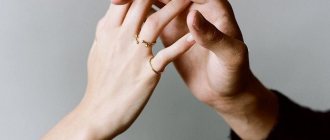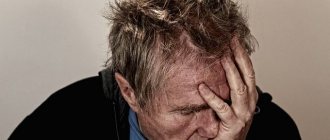The term anhedonia was first introduced into clinical practice at the beginning of the 19th century to describe a condition that often accompanies not only mental but also somatic diseases, and which is characterized by a decrease or complete inability to enjoy activities that are pleasant for the vast majority of people, for example, a favorite hobby , delicious food, sex. Currently, such a syndrome is considered one of the main criteria for depressive disorders and schizophrenia.
Causes
The etiology of anhedonia is believed to be related to:
- hereditary predisposition, especially if this disorder is the first sign of schizophrenia;
- severe nervous shocks both in childhood and in adulthood;
- unsuccessful experiences in family relationships, episodes of sexual and physical violence;
- congenital or acquired (trauma, stroke, tumor) brain pathologies;
- concomitant severe somatic diseases, especially with a poor prognosis, for example, oncology, HIV, hepatitis, etc.;
- low income and social status.
Dysfunction of the dopaminergic and, to a lesser extent, noradrenergic system of the brain is of great importance in the pathogenesis. Impaired production of neurotransmitters causes the clinical manifestations characteristic of anhedonia. But in recent years, a new hypothesis has emerged suggesting a connection between the disorder and a systemic inflammatory process, in which the overall cytokine profile changes and the activity of the hypothalamic-pituitary system and adrenal glands increases.
Autism
The concept of “autism,” according to many psychiatrists, despite repeated attempts to define the “autistic spectrum of symptoms,” remains quite vague.
It appears that autism is a complex syndrome, possibly integrating a number of manifestations of schizophrenia, including cognitive and emotional impairments, as well as behavioral changes.
According to E. Bleuler (1911), autistic thinking is divorced from reality, judgments are formed in accordance not with logic and real facts, but with the affective needs of the patient.
According to G. Benedetti (1983), autism and the primary symptoms of splitting are two sides of the same disease process. In this case, autism is interpreted by the author as a protective-compensatory reaction to splitting.
Many researchers have emphasized that autism to some extent excludes empathy.
Patients become less accessible to natural external stimuli. The surrounding world, physical reality, attracts them to a much lesser extent than their own inner world, which, according to patients, is more interesting and deep.
Autism intensifies with delirium and oneiric clouding of consciousness.
Patients strive for isolation, become withdrawn, silent, have formal contact with others, showing an indifferent attitude even towards close people. “They... go into the quiet, undisturbed world of their ghosts” (Schüle G., 1988).
Passivity is a fairly common companion to autism. The patient may not leave the house for a long time and lie in bed for a long time. Here there is a violation of social communications, a narrowing of the circle of communication and, most importantly, the need for it.
Differential diagnosis of autism symptoms in schizotypal, schizoaffective disorders and paranoid schizophrenia is presented in Table 13.
Autism syndrome includes signs of altered thinking: increased passive imagination and impaired logical reasoning. It is difficult for a patient with schizophrenia with distinct symptoms of autism to put himself in the shoes of another person, to recognize his feelings, to understand what the latter means, what meaning he puts into his words and what his intentions are.
Studies have shown that a person with schizophrenia, no matter how developed his intelligence, has difficulty understanding incorrect statements and deception.
In autism, certain intersections can be traced with the difficulty of understanding oneself, insufficient autobiographical memory, and impaired reasoning ability.
Table 13. Differential diagnosis of autism symptoms in schizotypal, schizoaffective disorders and paranoid schizophrenia
| Schizophrenia spectrum disorders | Schizotypal disorders | Schizoaffective disorders | Schizophrenia |
| Behavior | Changes in external behavior, its stereotyping | Passive submission | Ambivalent behavior |
| Social communications | Changes in social communications, isolation, unsociability, loss of interest in public life | Narrowing the circle of interests | Social isolation, isolation |
| Thinking | Violation of the adequacy of the goals set, due to switching to the world of the desired imaginary reality | Decline in creativity | Reasoning, amorphous thinking. Various forms of autistic thinking: overvalued and delusional variants, delusional fantasizing |
| Personality Features | Introversion, decreased mental flexibility and personality plasticity, rigidity | Leveling individual properties of temperament | Apathy, abulia |
| Attitude to illness | Total anosognosia | Nosognosia (shift of the disease into the past, psychologization and somatization, recognition of individual signs of the disease | Partial anosognosia |
Supporters of Z. Freud interpreted autism and decreased activity as an unsuccessful attempt at pathological compensation, “a separation from the orientation to reality.” Thus, the biological genesis of a number of manifestations of schizophrenia was denied.
According to the information theory, especially popular in the 60-70s of the twentieth century, blocking information when the brain is unable to adequately process it contributes to the emergence of autism in schizophrenia (Nuller Yu.L., 2000).
In childhood, the first descriptions of autism belong to H. Asperger (“Autistic psychopathy in childhood,” 1944) and L. Kanner (“Nervous Child,” 1943). Interest in childhood autism increased significantly after the work of L. Wing (1981). The incidence of autism is 10 per 10,000 population, Asperger's syndrome - 2 per 10,000 population. Boys get sick more often than girls, in an approximate ratio, according to ICD-10 8:1. Differential diagnosis of autism and Asperger's syndrome due to some social neglect, communication impairment, limited interests, stereotypical behavior is usually carried out with such mental disorders as obsessive-compulsive, schizoid/schizotypal personality changes, social phobia and schizophrenia.
Clinical picture
Experts believe that it is not anxiety and apathy, but anhedonia that is the key factor in decreased performance and general social maladjustment. Without proper treatment, such a disorder leads to other psycho-emotional disorders: pathological indifference and indifference, low sociability, loss of motivation. In an effort to compensate for the lack of pleasure, people suffering from anhedonia usually smoke, abuse alcoholic beverages, and take drugs (and as practice shows, these are powerful, dangerous modern synthetic psychostimulants that are addictive after 2-3 doses).
The desire for pleasure is the basis, the core of the entire motivational system. This is what pushes one to learn, make new acquaintances, and find a well-paid job. A person with anhedonia cannot rejoice at the successes of loved ones or pleasant events occurring in the family (the birth of a child, birthdays and other holidays).
Kinds
There are several clinical variants of the course of anhedonia:
- Physical , in which there is no ability to experience sensual and bodily pleasures. A person is indifferent to his own appearance, does not take care of himself, and does not even observe basic hygiene rules. Food is only a source of replenishing the calorie deficit; the patient is completely indifferent to its quality, he is only interested in its energy value.
- Social. Characterized by complete indifference to various social contacts (we are talking about both friendly and relationships with the opposite sex). The patient strives to limit communication as much as possible. Libido decreases, total indifference appears, and in some cases aversion to sexual contacts appears.
- Intellectual and aesthetic. Typically there is a lack of feeling of pleasure and satisfaction from the process of learning something new, contemplating masterpieces of world culture, etc. Life becomes very limited: home and work, and without the desire for career growth and promotion. The intellectual level decreases, interest in hobbies and interests is lost.
Associated symptoms
Neglect of one’s own health, and the emotional state characteristic of anhedonia, leads to a variety of somatic disorders. This:
- insomnia;
- feeling of constant fatigue, exercise intolerance;
- dyspnea;
- weakness and lethargy;
- headaches, discomfort in the heart area, arthralgia, myalgia;
- decreased immune defense, which increases the risk of complicated bacterial, fungal and viral infections;
- hypoxia, vitamin deficiency due to unbalanced nutrition;
- obesity or, conversely, sudden weight loss, muscle atrophy.
In recent years, the psychosomatic nature of various diseases has been actively studied. According to experts, malignant neoplasms, pathologies associated with immune hyperactivity (rheumatoid arthritis, colitis, etc.), endocrine disorders can also be a consequence of anhedonia.
Establishing diagnosis
There are no tests specifically designed to measure anhedonia. The presence of the disease is revealed by interviewing the person. The specialist is interested in the patient’s pastime: whether he takes part in various types of social activities, whether he attends the theater, exhibitions, cinema, concerts, how often this happens and how it affects the person’s emotional state. You can ask questions directly: does a person enjoy doing handicrafts, gardening or other hobbies, or crowded events? If a person has no friends, is socially inactive, does not attend crowded places and mass events, this can be considered a basis for making a diagnosis.
Diagnostic features
Agnedonia often manifests itself even before the appearance of clinical signs of the underlying disease. That is why diagnostic procedures (questionnaires using specially designed questionnaires, instrumental examination to exclude organic lesions of the central nervous system) are aimed at identifying possible serious mental disorders. Starting therapy in the early stages greatly increases the likelihood of a favorable outcome (complete cure or achieving long-term remission).
Sometimes, especially if the patient actively protests against visiting the clinic and has characteristic symptoms, doctors recommend testing for the presence of narcotic substances in the body. Additional examination is also needed to identify possible concomitant diseases.
In some cases, symptoms of such a disorder occur in people with certain mental characteristics, the so-called “depressive temperament.” But even in such cases, doctors at the Leto clinic select a regimen of drug treatment and psychotherapy to give the patient the opportunity to live a full life.
Addition
There is a drug called Sildenafil, which is sold under the name "Pink Viagra" or "Viagra for women." The medicine was created by pharmacologists from Pfizer and is excellent at combating sexual problems that can arise when taking antidepressants.
In August 2015, it became known that the drug Flibanserin, another analogue of Viagra, specially designed for women, had passed all the necessary research and testing and was approved for sale in America. The medication is able to create and enhance desire and sexual desire in the fairer sex. Its creation became known several years ago. Now the drug has appeared on pharmacy shelves under the Abbyi brand.
How to get rid of the disorder: treating anhedonia in
Anhedonia requires a comprehensive approach. If we are not talking about schizophrenia and other mental illnesses with impaired consciousness, hospitalization is not necessary. A course of psychotherapy is required. It is important for the doctor to understand the causes of emotional decline, to find out what the patient feels when remembering a traumatic situation, what exactly causes mood changes (both for the better and for the worse).
Sometimes family psychotherapy is required, since the psycho-emotional state of the patient often becomes the cause of discord with loved ones and the rapid deterioration of relationships with relatives. It is not enough to solve the problem of how to cure anhedonia; subsequent social adaptation is no less important.
Drug treatment
Drug prescriptions largely depend on diagnostic results. The basis of therapy is antidepressants, and the specific drug and its dose are always selected individually. Additionally used:
- sedatives to normalize sleep;
- tranquilizers (strictly according to indications for severe mental disorders);
- vitamins, medicines containing amino acids necessary for complete metabolism;
- nootropics;
- drugs for correcting metabolic processes;
- drugs for the treatment of concomitant diseases.
How to relearn how to enjoy life
Even realizing the presence of anhedonia, not every person has the opportunity or desire to seek professional help from a specialist. In this case, you can try to improve your condition on your own, and to do this you should take the following 3 steps.
Step 1. Decide to help yourself
This is the most important, and for many, the most difficult point of the program. Firstly, any action begins with a decision. Secondly, in cases of so-called self-psychotherapy, it can be difficult for a person to first admit that he has a problem, and then to believe that he is able to help himself.
Step 2. Find a source of pleasure
If the old sources of pleasure no longer work, then it is necessary to find new ones. What is important is that “search work” should extend to all spheres of life. It is necessary to include smell, vision, touch, taste, hearing, and body movements. Moreover, each of these groups must be studied very carefully, for example, within 2 days.
Take the sense of smell, for example. The coming Monday and Tuesday can be devoted to studying smells. These could be aromas in a perfume store, the smell of plants, fruits, herbs, vegetables, spices, essential oils. You should study aromas slowly, writing down those that you like at least a little.
Wednesday and Thursday can be spent studying the sense of touch. The goal of this exercise is to find surfaces that bring tactile pleasure. This exercise is best done with your eyes closed. Over the course of two days, a person will have to deliberately touch a variety of objects. These can be stones, leather, fur, paper, bulk and creamy substances, glass, cotton wool. Among them there will definitely be something that seems pleasant to the touch.
The next two days can be devoted to studying your taste sensations. It is better to start “research” with simple products, for example, familiar fruits, vegetables, chocolate or baked goods. Then gradually add new spices and unusual combinations of products. During the exercise, you should carefully concentrate on your own feelings, determine what you ate tasted the most pleasant.
The seventh and eighth days are the time to study sounds. It’s best to start with the sounds of nature. For example, listen to the sound of rain, wind, sounds of water, voices of different birds and animals. Then you can move on to music. But don’t force yourself to listen to the tunes you liked before. The purpose of the exercise is to find new sounds that would be pleasant to the ear.
Best materials of the month
- Coronaviruses: SARS-CoV-2 (COVID-19)
- Antibiotics for the prevention and treatment of COVID-19: how effective are they?
- The most common "office" diseases
- Does vodka kill coronavirus?
- How to stay alive on our roads?
After this exercise, you can turn your attention to visual images. You can consider anything: from color combinations to a variety of items. Among this multitude, there is sure to be at least something that will sincerely interest you. But it is important to consider objects thoughtfully, slowly, listening to your feelings.
Well, it is useful to devote the last two days of this stage of self-therapy to the search for kinesthetic pleasures, that is, the pleasures of movement. During this period, you can try everything: from dancing, swimming and yoga to martial arts. The main thing is to find those movements that you enjoy doing.
Of course, this does not mean that the practice should end after these 12 days. The listed exercises can be repeated exactly as long as a person needs to find new sources of pleasure for himself. But here you need to be extremely careful so that the source of joy does not become a source of new problems (with health, law, etc.).
Cost of services
| CONSULTATIONS OF SPECIALISTS | |
| Initial consultation with a psychiatrist (60 min.) | 6,000 rub. |
| Repeated consultation | 5,000 rub. |
| Consultation with a psychiatrist-narcologist (60 min.) | 5,000 rub. |
| Consultation with a psychologist | 3,500 rub. |
| Consultation with Gromova E.V. (50 minutes) | 12,000 rub. |
| PSYCHOTHERAPY | |
| Psychotherapy (session) | 7,000 rub. |
| Psychotherapy (5 sessions) | 30,000 rub. |
| Psychotherapy (10 sessions) | 60,000 rub. |
| Group psychotherapy (3-7 people) | 3,500 rub. |
| Psychotherapy session with E.V. Gromova (50 minutes) | 12,000 rub. |
| TREATMENT IN A HOSPITAL | |
| Ward for 4 persons | 10,000 rub./day |
| Ward for 3 persons | 13,000 rub./day |
| Ward 1 bed VIP | 23,000 rub./day |
| Individual post | 5,000 rub. |
| PETE | 15,000 rub./day |
This list does not contain all prices for services provided by our clinic. The full price list can be found on the “Prices” , or by calling: 8(969)060-93-93. Initial consultation is FREE!
Non-drug therapy
In addition to psychotherapy and a course of medication, the patient needs:
- moderate physical activity: taking into account the patient’s health condition, an individual program of exercises under the guidance of a rehabilitation specialist is recommended;
- nutritional correction with the mandatory introduction of foods rich in essential vitamins, macro- and microelements into the diet; the daily amount of calories is calculated depending on the patient’s body weight;
- balneotherapy;
- massages, play reflexotherapy.
Specialized doctors have extensive practical experience, so they know very well how to treat anhedonia and promptly recognize the symptoms of other, more dangerous diseases. By contacting us with your problem, you will see that the grateful reviews from the clinic’s clients are further proof of the highest professionalism of our doctors. Call us at 8(969)060-93-93 . Our consultant will answer all questions, select a convenient time for a visit to a specialist, or fill out an application to call a psychotherapist at home.
Alogia
Many patients with schizophrenia are laconic; they are characterized by low speech productivity, slowness in answering questions, and monosyllabic statements.
Alogy:
- Monosyllabic statements.
- Poverty of speech content.
- Delay in answering a question (“answering after a long pause”).
Traditionally, alogia is described in the structure of negative symptoms of schizophrenia. In our opinion, this rather complex psychopathological phenomenon is partly a consequence of the neurocognitive deficit characteristic of schizophrenia.
Return to Contents
Definition
The term “anhedonia” was first introduced by Théodule Ribot in 1896, and he defined it as a limited ability to experience pleasure. “There are many types of pathological depression. Sometimes it is the usual passive joylessness and hopelessness, depression, lack of taste for anything, enthusiasm, energy. "Professor Ribot proposed the name 'anhedonia' to describe this condition." Previously, this term was used to refer to “affective dulling” (“affective flattening”), that is, to describe the weak expressiveness of emotions, gestures and facial expressions in a person. Which was especially often used in the context of post-traumatic stress disorder. Also, early definitions of anhedonia focused on the person's lack of feelings of satisfaction. Current conceptualizations emphasize the need to examine other aspects of enjoyable activities, such as motivation or desire to engage in a particular activity (motivational anhedonia) as opposed to the level of enjoyment of the activity itself.
Warning
Depression is a life-threatening condition, and following your doctor's orders is critical—even if the medications cause sexual dysfunction. Even despite the obvious fact that problems in the sexual sphere themselves can cause serious psychological distress, loss of self-esteem, deterioration in quality of life - that is, symptoms of depression.
If the medications you are taking to treat depression are preventing you from enjoying life to the fullest, it may make sense to talk to your doctor about it and make changes.
Source: enidnews.com
All materials on the site are presented for informational purposes only, approved by a certified physician, Mikhail Vasiliev, diploma series 064834, in accordance with license No. LO-77-005297 dated September 17, 2012, a certified specialist in the field of psychiatry , certificate number 0177241425770.










